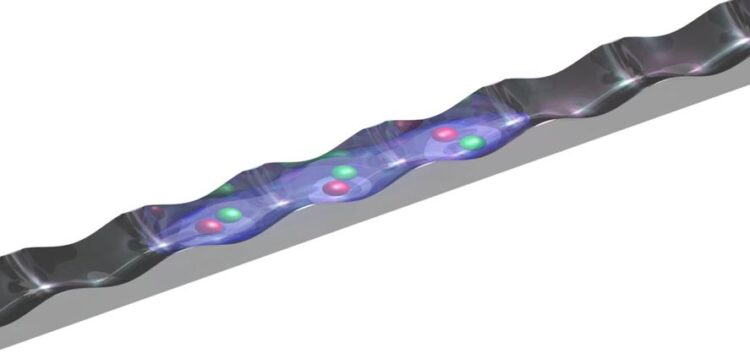New theory to explain one dimensional quantum liquids formation

One dimensional quantum lattice liquids.
Credit: I. Morera et al. Phys. Rev. Lett
Liquids are ubiquitous in Nature: from the water that we consume daily to superfluid helium which is a quantum liquid appearing at temperatures as low as only a few degrees above the absolute zero. A common feature of these vastly different liquids is being self-bound in free space in the form of droplets. Understanding from a microscopic perspective how a liquid is formed by adding particles one by one is a significant challenge.
Recently, a new type of quantum droplets has been experimentally observed in ultracold atomic systems. These ones are made of alkaline atoms which are cooled down to extremely low temperatures of the order of nanokelvins. The main peculiarity of these systems is that they are the most dilute liquids ever experimentally observed. An extraordinary experimental control over the system opens the possibility of unraveling the mechanism leading to the formation of quantum droplets.
In a recent article published in Physical Review Letters, researchers from the Institute of Cosmos Sciences of the University of Barcelona (ICCUB) Ivan Morera and the late Prof. Artur Polls led by Prof. Bruno Juliá-Díaz, in collaboration with Prof. Grigori Astrakharchik from UPC, present a microscopic theory of lattice quantum droplets which explains their formation.
The team of researchers has shown that the formation of the quantum droplet can be explained in terms of effective interactions between dimers (bound states of two particles). Moreover, by solving the four-body problem they have shown that tetramers (bound states of four particles) can appear and they can be interpreted as simple bound states of two dimers.
The properties of these tetramers already coincide with the ones of large quantum droplets which indicates that many of the feature properties of the many-body liquid are contained in the tetramer. They also discussed the possibility of observing these strongly correlated droplets in dipolar bosons or bosonic mixtures in optical lattices.
All latest news from the category: Physics and Astronomy
This area deals with the fundamental laws and building blocks of nature and how they interact, the properties and the behavior of matter, and research into space and time and their structures.
innovations-report provides in-depth reports and articles on subjects such as astrophysics, laser technologies, nuclear, quantum, particle and solid-state physics, nanotechnologies, planetary research and findings (Mars, Venus) and developments related to the Hubble Telescope.
Newest articles

Innovative 3D printed scaffolds offer new hope for bone healing
Researchers at the Institute for Bioengineering of Catalonia have developed novel 3D printed PLA-CaP scaffolds that promote blood vessel formation, ensuring better healing and regeneration of bone tissue. Bone is…

The surprising role of gut infection in Alzheimer’s disease
ASU- and Banner Alzheimer’s Institute-led study implicates link between a common virus and the disease, which travels from the gut to the brain and may be a target for antiviral…

Molecular gardening: New enzymes discovered for protein modification pruning
How deubiquitinases USP53 and USP54 cleave long polyubiquitin chains and how the former is linked to liver disease in children. Deubiquitinases (DUBs) are enzymes used by cells to trim protein…


